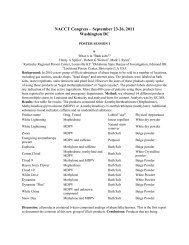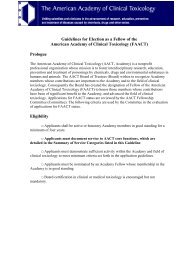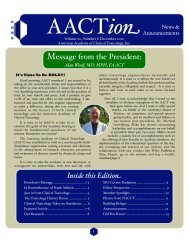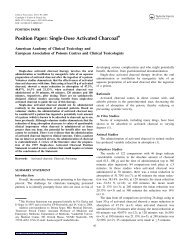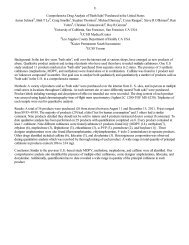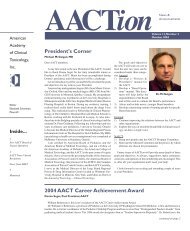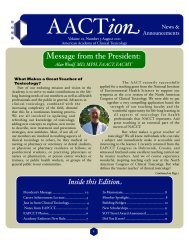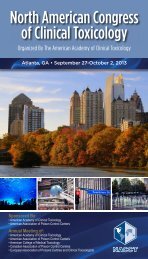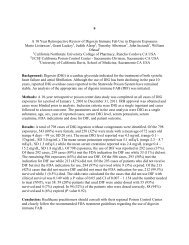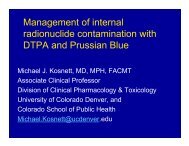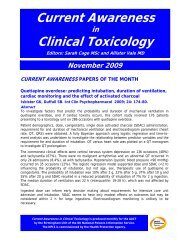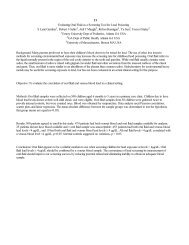Posters IV - The American Academy of Clinical Toxicology
Posters IV - The American Academy of Clinical Toxicology
Posters IV - The American Academy of Clinical Toxicology
You also want an ePaper? Increase the reach of your titles
YUMPU automatically turns print PDFs into web optimized ePapers that Google loves.
Background: An explosion occurred on the drilling rig Deepwater Horizon on April 20, 2010. <strong>The</strong><br />
release <strong>of</strong> oil that occurred in the months after the rig sank is among the largest in history, with some<br />
estimates exceeding 200 million gallons before the well was finally capped on July 15, 2010. An oil slick<br />
was noted at the site <strong>of</strong> the accident on April 22, touching <strong>of</strong>f massive response efforts involving tens <strong>of</strong><br />
thousands <strong>of</strong> individuals. Discussion: Poison Control Centers were asked to participate in the early stages<br />
<strong>of</strong> the response by the U.S. Coast Guard, the agency in charge <strong>of</strong> the Unified Command. Callers with<br />
medical issues or medical questions about the spill were directed to call the Poison Center hotline number<br />
for assistance. As the response grew the Poison Centers role expanded. Poison Centers provided case<br />
information from the National Poison Data System (NPDS) to health departments in all states bordering<br />
the Gulf <strong>of</strong> Mexico. In some gulf states the Poison Center was the single initial reporting point for medical<br />
support issues. Frequent situation reports were provided to various agencies and individuals with key roles<br />
in the response. <strong>The</strong>se sitreps described the activities <strong>of</strong> the Poison Centers and provided up to date<br />
information about the numbers and types <strong>of</strong> cases reported. Poison Centers were asked to participate in<br />
multi-state planning sessions for spill related health issues. Center staff members were asked to sit on<br />
committees and taskforces formulating response plans for issues including food and water safety as well<br />
as air quality issues. Initially the majority <strong>of</strong> cases reported involved inhalation exposure, but as the oil<br />
moved onto the shore dermal and ingestion exposure routes were noted as well. Poison Center staff<br />
assisted in over one thousand exposure calls as a result <strong>of</strong> the spill and the cleanup efforts. By June<br />
websites including deepwaterhorizonresponse.com, restorethegulf.gov, CDC.gov, EPA.gov, BP.com, and<br />
state health department sites all listed the national poison help hotline, 1-800-222-1222, as the primary<br />
number to call for those individuals in need <strong>of</strong> medical support or for those who had medical information<br />
questions. Poison Centers continue to assist in the response and will do so as long as necessary. Results:<br />
<strong>The</strong> gulf oil spill marked the most significant involvement in a large scale emergency response in Poison<br />
Centers history. New partnerships were formed that will certainly lead to greater Poison Center utilization<br />
in future emergency preparedness plans and responses.<br />
251<br />
Using a Pediatric Primary Care Site to Promote Carbon Monoxide Safety in an Underserved Urban<br />
Population<br />
Risa Small 1 , Tamara Miller 1 , Paulette Smith 2 , Peter Palermo 2 , Fred Henretig 1 , Kevin C Osterhoudt 1<br />
1 <strong>The</strong> Children's Hospital <strong>of</strong> Philadelphia, Philadelphia PA 2 Philadelphia Department <strong>of</strong> Health<br />
Background: Carbon monoxide (CO) poisoning is a preventable, yet leading cause <strong>of</strong> unintentional<br />
poisonings in the United States. Non-fire related CO poisoning causes approximately 450 deaths and more<br />
than 20,000 emergency room visits annually. Children aged < 5 years and minority populations are at<br />
increased risk <strong>of</strong> CO poisoning. Currently only 12% <strong>of</strong> homes in Philadelphia County have a CO detector.<br />
We sought to assess the feasibility <strong>of</strong> using a primary care pediatric <strong>of</strong>fice setting to provide an<br />
intervention to increase CO home safety, and to assess for changes in behavior related to CO risk<br />
following this program. Methods: As part <strong>of</strong> an "advocacy" curriculum within a pediatric residency<br />
training program, families at an urban pediatric primary care <strong>of</strong>fice were recruited if they presented for a<br />
newborn visit, reported no CO detector in their home, and were residents <strong>of</strong> Philadelphia County. Eligible<br />
families were referred for a free home safety inspection and installation <strong>of</strong> a CO detector by the city<br />
Department <strong>of</strong> Health. City inspectors were also trained to provide CO prevention education. A pre-and<br />
post-inspection questionnaire was used to assess prior knowledge <strong>of</strong> CO and intention to change behaviors<br />
to minimize subsequent CO exposure. Results: From October 1, 2010, thru April 1, 2011, 154 families<br />
were recruited. Of the 154 families, 52 homes (50 self-describe as African-<strong>American</strong>, 2 as Hispanic) have



